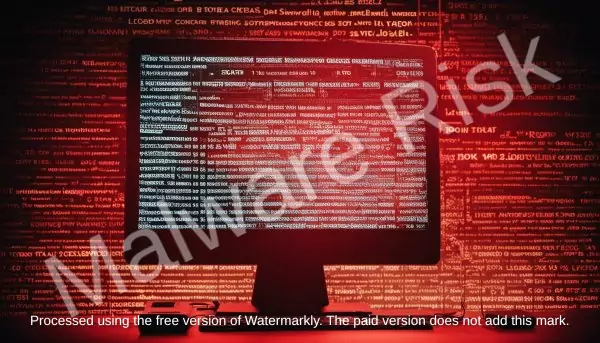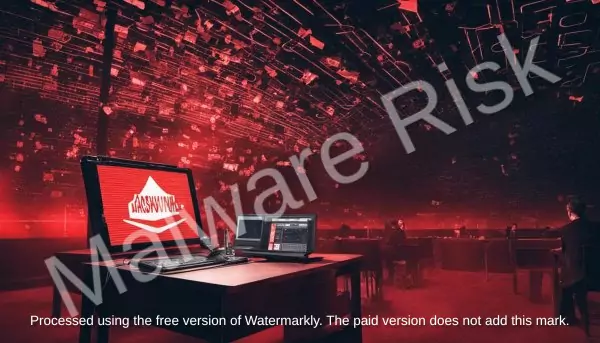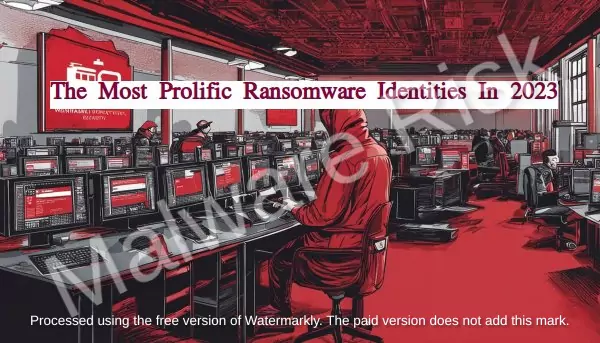In today’s world, the digital space doesn’t only give us the luxury of convenience through intelligent machines and software. It also opens up Pandora’s box of malicious code and programs designed with ill intentions. One such dark side of the tech world comes in the form of ransomware. A ransomware attack is a cybersecurity threat that doesn’t spare anyone, anytime, be it individuals or organizations. Its daunting effects lead to compromised systems, data encryption, and demand a ransom to grant back access. This discussion shines a spotlight on the Top 15 ransomware families that continue to be a severe cyber risk in 2023, including high-profile names like WannaCry, Ryuk, and BitcoinBlackmailer, amongst others.
Quick Links
WannaCry Ransomware
WannaCry: The Persistent Ransomware Threat

Still wreaking havoc in 2023, WannaCry remains a significant cyber threat that should not be underestimated. While it first gained international notoriety back in 2017, its unceasing presence just goes to show the relevance and durability of this malware family.
The primary reason for its persistent presence in the threat landscape is its tactical mechanism: exploiting vulnerabilities in outdated software. WannaCry ransomware infiltrates machines running unpatched or unsupported versions of Windows to achieve its nefarious goals.
Upon successful infiltration, the ransomware encrypts a vast array of file types on the victim’s system, rendering the data practically inaccessible. Once the encryption process is completed, the victim is presented with a lock screen, informing them that their files have been ‘kidnapped’ and that they must pay a ransom in Bitcoin to regain access to their files.
However, paying the ransom does not guarantee the safe return of the data, leading many cybersecurity experts to advise against taking such action. Instead, they advocate for regular data backups and keeping software up to date to prevent falling victim to the WannaCry ransomware.
It’s important to be aware that while software developers often issue patches to mitigate vulnerabilities, these patches are only effective if they are installed. Therefore, users and system administrators bear a significant amount of responsibility for ensuring their systems are updated. Updating operating systems and applications can significantly reduce the risk of WannaCry infection, highlighting the need for vigilance and a proactive approach in cybersecurity practices.
One final note on WannaCry. It’s essential to understand that ransomware, including the likes of WannaCry, is not just a standalone product. It evolves, with new versions continually being developed and its mechanisms refined. So, while the threat of WannaCry ransomware remains, it’s no longer the same as the 2017 version – it’s a more evolved, insidious digital enemy. That’s why cybersecurity defenses need to continually adapt too, staying one step ahead to deal with this ever-present cyber threat. It’s indeed a cybersecurity arms race, with WannaCry a notorious player demonstrating the need for constant vigilance in an always-connected digital world.
Ryuk Ransomware
Persistent Threat: Ryuk Ransomware
The Ryuk Ransomware, initially detected in 2018, remains a potent and active cybersecurity threat in 2023. Known for its targeted approach, Ryuk primarily focuses on disrupting organizations in critical sectors. These sectors include those where downtime can result in far-reaching consequences, such as logistics, healthcare, and the public sector.

Targeting Mechanism
The Ryuk ransomware operates by infiltrating systems via malicious email campaigns or through infected networks. Once active, it encrypts victim’s files and demands large sums of bitcoin as ransom. An alarming attribute of Ryuk is its capacity to lay dormant for a significant amount of time, potentially weeks or months, before activating and making its presence known. This unique trait can make it incredibly difficult to detect and mitigate before it springs into action.
Impact Analysis
The impact of Ryuk cannot be understated; it can render affected systems unusable, often leaving organizations with no choice but to comply with the attacker’s ransom demands. This ransomware directly influences the organization’s ability to function effectively and can lead to severe operational and financial repercussions. When targeting logistics or healthcare systems, it can disrupt critical supply chains, transport operations, patient care, and potentially threaten lives.
Mitigation Strategies
Mitigating the dangers of the Ryuk ransomware involves a multi-faceted approach. Organizations should regularly conduct cybersecurity awareness training to reduce the risk of employees accidentally activating the ransomware through phishing emails. A strong cybersecurity infrastructure that includes regular system backups, up-to-date firewall defenses, and ongoing threat monitoring is crucial in preventing Ryuk from achieving its devastating effects. Additionally, immediate isolation of infected systems can help halt the spread of the ransomware.
The Persistence of Ryuk
The continued activity of the Ryuk ransomware in 2023 demonstrates its adaptability and the persistent threat it poses to organizations. Despite advances in cyber defense technologies, Ryuk’s evolution and persistence serve as a grim reminder of the ongoing struggle against cybercrime. Its focus on critical sectors highlights the need for robust cybersecurity measures within organizations. The stagnation is not an option for those who wish to avoid the disruptive and damaging consequences of a Ryuk ransomware attack.
Locky Ransomware
Locky Ransomware: A Digital Lockdown
During the age of rapidly evolving digital threats, Locky remains a timelessly stubborn ransomware family. This malicious code encrypts users’ data, effectively blocking access to all types of files, from images to vital documents. The transformation of these files into ‘locky’ file extension earmarks its malicious activity. Once the encryption process is complete, victims find their digital belongings under lock and key, with the hackers holding the only set.

The Modus Operandi
The distribution of this ransomware predominantly occurs via seemingly harmless emails. By employing social engineering tactics, the culprits behind Locky easily deceive its prospective victims. An unsuspecting user might be greeted with what seems like an innocent email attachment or a link. Upon clicking, the attachment or link initiates the deployment of the ransomware into their system, marking the beginning of an unwelcome digital siege.
Why Locky Remains Relevant
Despite the development of several other potent ransomware families, Locky continues to retain its position amongst the top contenders. This is due largely to its widespread distribution strategy and persistent variants. Over time, it has evolved in both its encryption methods and its infection vectors. This adaptability contributes to its ongoing menace.
Countermeasures and Protection
Effective measures to combat Locky include maintaining up-to-date antimalware software, routinely backing up important files, and most importantly, implementing a secure email protocol, such as not opening suspicious emails or clicking on unknown links. In addition, educating employees or users about the threat of malicious emails and the dire consequences of ransomware infections can go a long way in preventing Locky attacks.
Decoding The Danger
Users who are unfortunate enough to be infected by Locky are often presented with a ransom demand, typically payment in a cryptocurrency such as Bitcoin. The best course of action in such a situation is to report the crime to the nearest cybercrime agency and not yield to the demand of the cybercriminals. While it may seem tempting to regain access to one’s files, remuneration only fuels these illicit activities. This is Locky in 2023 – still thriving, still evolving, and a prominent character in the ransomware saga.
CryptoLocker Ransomware
CryptoLocker: A Historic Ransomware Family
CryptoLocker, first emerging in 2013, carved its name as one of the first ransomware families to achieve widespread success. Countless victims across the globe found themselves cornered into paying hefty ransoms to survive crippling cyber-attacks, proving CryptoLocker’s potency as an unwavering threat.

An oft-used delivery method has been spear-phishing emails, triggering unsuspecting victims into downloading the ransomware. Once inside the system, CryptoLocker conveniently finds and encrypts files, only allowing access after the ransom is paid. The clock-ticking countdown, minimizing the window for response, adds undeniably to the urgency and dread.
CryptoLocker’s Perseverance
Fast forward to 2023, and CryptoLocker continues to thrive in the constantly evolving world of cyber threats. While traditional defenses have become smarter, so too, have attacks advanced in sophistication. Several formidable versions of its kind continue to circulate in the wild, providing evidence of its continued threat to global cyber health.
CryptoLocker’s secret to survival? An uncanny ability for adaptation. Its architects have introduced more complex encryption algorithms while refining their delivery methods, constantly adding to its devastating potential.
Matrix Evolution of CryptoLocker
Worryingly, the adaptability of the ransomware means there are now more versions of CryptoLocker available than ever before. These variations include the likes of CryptoWall, TorrentLocker, and TeslaCrypt. While they have their unique attributes, they all follow the same ruthless motto: encrypt, demand, and force victims to pay while inciting absolute terror.
Growing Sophistication and Proliferation
By 2023, CryptoLocker’s impact remains fearsome, with it handling itself confidently among the top 15 ransomware families. Its continued success and proliferation are attributable to its relentless campaign of innovation and evolution. The cybersecurity world must keep pace to face off this resilient adversary armed with robust protections, vigilance, and proactive incident response strategies.
BitcoinBlackmailer Ransomware
BitcoinBlackmailer: The Rise of Crypto-based Ransomware
2023 saw a major shakeup in the world of cyber threats, with numerous ransomware families vying for infamy. Among the leading contenders, BitcoinBlackmailer rapidly climbed the ranks. The primary reason behind its speedy ascension was its exclusive demand for ransoms to be paid in Bitcoin.

BitcoinBlackmailer successfully capitalized on the growing mainstream popularity of Bitcoin and the general upsurge in other cryptocurrencies. It demonstrated a stark reality: the more sought-after these currencies are, the more ransomware developers are incentivized to specialize their malware towards them.
Leveraging Cryptocurrency Anonymity
A key facet of BitcoinBlackmailer’s strategy was the exploitation of the inherent anonymity provided by cryptocurrencies, especially Bitcoin. This not only made it nearly impossible to track the transgressors, but it also facilitated speedy transactions, assurance of payment, and minimal risk of detection for the cybercriminals.
Threat Landscape Characterization
This ransomware family exhibited a multifaceted approach to encryption. BitcoinBlackmailer adopted both symmetric and asymmetric encryption schemes, rendering the decryption process incredibly complex without the unique key held by the attacker. Consequently, this intensified the sense of urgency and despair for the victims while strengthening the attackers’ bargaining position.
Targets and Impact
BitcoinBlackmailer was not particular about its targets and cast a wide cybernetic net to snare victims. Businesses, institutions, and individuals all fell prey to this ransomware. With widespread attacks resulting in significant financial demands, BitcoinBlackmailer realized remarkable illicit gains and successfully cemented its place as one of the top ransomware families of 2023.
Defensive Strategies
On a brighter note, the rise of BitcoinBlackmailer further activated cybersecurity communities worldwide to counteract this malicious phenomenon. Experts focused on advanced detective measures, exploiting weaknesses in the ransomware’s code, and strengthening critical infrastructure defenses to protect against such threats.
Even though BitcoinBlackmailer shook 2023 with its audacious assaults, the experience was a crucial reminder and lesson. As the world continues to evolve digitally, the importance of cybersecurity in safeguarding this digital realm cannot be overstressed.
Emotet Ransomware
Emotet Ransomware Overview
Emotet is not just your typical ransomware, it is a sophisticated and robust malware framework that has made a significant impact on the cybersecurity landscape. It originated as a banking Trojan, mainly designed to steal financial data, but morphed over time into an expansive threat-delivery platform. Emotet’s versatile architecture allows for various modules to be loaded onto a compromised system, making it a dangerous tool for delivering a variety of malicious threats onto the infected machines.

Modularity and Functionalities
The modular structure of Emotet is what sets it apart from other ransomware families. This enables different functionalities as per the cybercriminal’s requirements. Some modules are dedicated to stealing data, others are for self-propagation, while a few are used for deploying additional malware. Emotet’s ability to serve as a ‘dropper’ is particularly notorious – it can install other malicious programs like TrickBot and Ryuk ransomware, thereby augmenting its damaging potential.
Infection Techniques
Emotet’s primary mode of distribution is through malicious emails. These emails contain weaponized Microsoft Word documents or insecure URL links disguised as invoices, shipping notices, or other business-related documents. Once a user opens these documents or clicks the link, Emotet gets a foothold into their system and can further download and install additional malware.
Evolution and Upgrades
Emotet has undergone several iterations over the years, each version more advanced and evasive than the last. It is continuously updated to evade detection, enabling it to slip past antivirus software and other defensive measures. Features like its polymorphic nature, i.e., ability to frequently alter its code, makes it extremely challenging for traditional security tools to spot and block.
Threat to Organizations
Given its capabilities and stealth, Emotet poses a significant threat to organizations across all sectors. Its Trojan capabilities can lead to substantial data loss, while its delivery mechanism can spread across a network rapidly, causing system outages and significant downtime. Moreover, it often leads to secondary infections, further escalating the damage and recovery cost.
Protection Measures
Protection against Emotet requires a layered security approach that includes regular system updates, robust security software, continuous monitoring, and most essentially, user education about the risks of phishing emails and unsafe links. Regular data backups are also crucial to prevent data loss in case of an infection. Ultimately, staying vigilant against such threats is a critical step in maintaining a strong cybersecurity posture.
GandCrab Ransomware
An Overview of GandCrab
Since its debut in 2018, GandCrab has not lost its lustre as one of the most potent ransomware families on the scene. Despite its age, it remains remarkably effective and prevalent in 2023. GandCrab is unique in its business model, operating as a Ransomware-as-a-Service (RaaS), where even cybercriminals with limited technical know-how can deploy it.

GandCrab: An Adaptable Threat
One of the reasons GandCrab has remained a top threat is its adaptability. The ransomware routinely updates its encryption algorithms to avoid detection by antivirus software. Further, it utilizes various propagation methods such as email phishing, exploit kits, and unsecured Remote Desktop Protocol connections, making it challenging to predict and counter.
The RaaS Model and GandCrab
What sets GandCrab apart is its Ransomware-as-a-Service (RaaS) model. This “business model” enables even novice cybercriminals to leverage its power. The developers of GandCrab offer the ransomware toolkit to other threat actors in exchange for a cut of the profits generated. It essentially extends its reach and lines of attack, increasing the possibility of successful infections.
The Financial Impact of GandCrab
GandCrab has been implicated in a plethora of successful attacks since its inception, causing economic damage in the millions of dollars range. The ransom demanded can vary dramatically, sometimes reaching thousands of dollars per victim, making GandCrab a colossal economic threat.
Mitigation Strategies Against GandCrab
Defending against GandCrab necessitates a multi-layered approach. Using updated security software can help detect and block known versions of the ransomware. Employing strong, unique passwords can bolster Remote Desktop Protocol security, while user education can mitigate the risk of successful email phishing attacks. Regular and secure backup of data also considerably minimizes the potential damage GandCrab can cause.
BadRabbit Ransomware
Bad Rabbit: An Evolved Ransomware Threat
First detected in 2017, the Bad Rabbit ransomware has proven incredibly resilient and continues to infect systems globally even in 2023. Leveraging the trust users have for well-known software, it disguises itself as an Adobe Flash updater to trick users into installing it. Once it is installed, it encrypts the user’s files, rendering them inaccessible until a ransom payment is made.

What Makes Bad Rabbit Dangerous?
The Bad Rabbit ransomware is particularly dangerous due to its method of delivery. Utilizing a legitimate-looking Adobe Flash update as a trojan horse, it easily tricks unsuspecting users into downloading and installing the ransomware. It shows how cybercriminals are keen on exploiting customer trust in well-established software brands to spread malware.
Impact and Damage Levels
The damage caused by Bad Rabbit ranges from temporary disruption of services to complete loss of data if the victim doesn’t have a proper back-up system in place. What’s worse, making the requested ransom payment comes with no guarantee of data being restored or the ransomware being completely removed. The cleanup effort post-infection can be significant, impacting personal and organizational productivity for an extended period.
Defensive Measures
Protection against Bad Rabbit requires a mix of user awareness, updated antivirus software, and good cybersecurity habits. Users should be wary of pop-up notifications asking them to update software, particularly those appearing outside the official application. Antivirus software should be kept up to date to detect and block known ransomware like Bad Rabbit. Regular data backup is also essential as a fallback plan to restore information if infection occurs.
Continued Threat in 2023
Despite the passing of years, Bad Rabbit continues to plague systems worldwide in 2023. This persistence highlights the craftiness of cybercriminals and the current digital landscape’s ongoing vulnerabilities. Cybersecurity protocols must continuously adapt to such evolving threats to maintain the safety of user data and systems.
Cerber Ransomware
Cerber Overview
Cerber originated as a major cybersecurity threat back in 2016 and following numerous evolutions, it still remains a potent danger in 2023. Throughout its existence, this unpleasant piece of ransomware has been continually updated with increasingly sophisticated attack methods. Ranging from exploiting unpatched security vulnerabilities to deploying a previously unfamiliar as-a-service model, Cerber has been able to consistently outpace cybersecurity defenses.

Targeting Methodology
One of Cerber’s key characteristics that set it apart and make it particularly dangerous in 2023 is its unique targeting methodology. Unlike other generic malware that scatters itself across the internet hoping to find a susceptible machine, Cerber actively seeks out cloud-based systems, namely Office 365 users. This precisely aimed attack strategy is part of what ensures Cerber can continually inflict significant damage on its victims.
Infamous Attack Techniques
To make matters considerably more challenging, Cerber’s attack methods have grown increasingly advanced and sinister. It was initially notorious for employing phishing emails to infiltrate systems. However, the current version has amped its threat status by incorporating machine learning techniques to profile potential victims and employing social engineering methods to gain access to their cloud-based accounts.
Sophisticated Encryption Algorithm
Once the ransomware successfully infiltrates a system, Cerber’s damage potential truly comes into focus as it utilizes a highly sophisticated encryption algorithm that locks out users from their data. The tight grip on the data is retained until a ransom is paid to the cybercriminals who control Cerber, hence enabling them to generate a steady stream of income from the victims’ desperation.
Post-Infiltration Tactics
In addition to encrypting data, Cerber goes a step further in utilizing scare tactics to coax victims into paying ransoms. One of the main ways it does this is through verbal notifications. The ransomware utilizes text-to-speech conversion methods to inform victims of the infection and guide them towards making payment. The added sense of urgency it creates further cements its position as a major threat even in 2023.
Sodinokibi Ransomware
Sodinokibi: The Ransomware Behemoth
First surfacing in 2019, Sodinokibi or REvil, as it is often referred to, is a significant actor in the world of cybercrime. This potent strain of ransomware holds its notoriety through its robust encryption and high ransom demands, making it a formidable threat to organizations worldwide.

Sophisticated Encryption Protocols
Sodinokibi is designed to encrypt data files on infected systems, effectively locking users out until a demanded ransom is paid. The ransomware uses a complex combination of RSA and Salsa20 encryption algorithms to lock files, making it almost impossible for users to regain access without the unique decryption key held by the attacker.
High Financial Exaction
Sodinokibi is also infamous for its high ransom demands. The ransom demanded can range from a few thousand dollars up to millions, depending on the victim’s data and business size. Unlike other ransomware strains that have fixed ransoms, REvil adjusts its demands based on an assessment of the victim’s ability to pay, which further testifies its sophistication.
Targeted Attack Vectors
This ransomware typically gains access through phishing emails, software vulnerabilities, and Remote Desktop Protocol (RDP) attacks. It is known to exploit unpatched vulnerabilities in commonly used applications and operating systems, gaining unnoticed access and spreading rapidly across the network.
Affiliate-Based Operating Model
Sodinokibi has an affiliate-based model, which means it outsources the infection process to third parties and shares a percentage of the ransom obtained. This modus operandi enables it to maximize its reach globally, affecting a wide array of sectors ranging from small businesses to large corporates and even government entities.
Implications of Sodinokibi Attacks
A Sodinokibi attack’s implications are far-reaching, affecting the victim’s daily operations, leading to significant financial losses, damaging their reputation, and possibly causing a breach of regulatory compliance. Therefore, it is vital for entities to take ample preventive measures like regular system updates, robust security infrastructure, frequent data backups, and user awareness programs about phishing attacks.
Dharma Ransomware
Dharma Ransomware Basic Information
Dharma ransomware, colloquially known as CrySIS, is notorious for its persistent threats that have haunted businesses and individuals over the years. This malware is designed to encrypt files and folders on infected machines, and then extort victims for a ransom to decrypt their data.

How Dharma Ransomware Operates
The operational method of Dharma sets it apart from others in the field. This ransomware family primarily exploits Remote Desktop Protocol (RDP) vulnerabilities to gain access to system. Once it infiltrates a system, it swiftly encrypts a wide array of file types, forcing victims into a corner where they are demanded to pay a hefty ransom for data recovery.
The Threat of Dharma Ransomware
Dharma’s unique signature lies in its use of different email addresses and decryption tools for its numerous variants. This makes it a moving target for cybersecurity experts attempting to combat its threats. Moreover, Dharma ransomware provides unique identification for each victim, adding another layer of complexity for those working on solutions.
Widespread Impact of Dharma Ransomware
Dharma ransomware has made a global impact with its myriad of attacks. Industries varying from healthcare to education, and from manufacturing to logistics, have felt the sting of Dharma. Its aggressive approach and ruthlessness in data encryption have cost organizations millions in ransom and mitigation expenses.
Ransomware Protection Measures
Though Dharma ransomware continues to be a prominent threat, there are some best practices one can adopt to mitigate the risk. Regularly updating software and security systems, implementing strong passwords, using two-factor authentication, and continuously backing up important files and data are indispensable actions that can possibly deter Dharma’s attempts to infiltrate in your system.
Countermeasures Against Dharma Ransomware
Various cybersecurity firms have developed decryption tools to combat Dharma ransomware, offering victims an alternate and less expensive route to data recovery. These tools are continuously updated to stay relevant and effective against the evolving versions of Dharma. Regular training and awareness campaigns are also crucial to ensure employees can recognize and avoid potential ransomware attacks.
NotPetya Ransomware
Malware in Disguise: NotPetya
NotPetya is an example of an increasingly prevalent phenomenon within the world of cybercrime: destructive malware camouflaged as ransomware. This crafty malware family first made waves in 2017, earning a dire reputation for its ability to wreak widespread mayhem on computer systems.

The main specialty of NotPetya lay inherently within its cunning guise of ransomware. This allowed it to bamboozle unsuspecting users into falling victim to its devastating attacks. Users were enticed into complying with ransom demands, only to realize that no amount of ransom could act as a panacea for their compromised systems.
Cyber Impact of NotPetya
The scale and impact of the attacks by NotPetya were truly unprecedented. The attacks weren’t merely focused on encrypting data but aimed at sabotaging system functionality entirely, thus causing immeasurable damage to businesses and governments worldwide. This approach rendered the traditional methods of ransom reprieve ineffective, intensifying the detrimental influence of its attacks.
Techniques Used by NotPetya
To achieve such havoc, NotPetya capitalized on several advanced techniques. It mainly deployed the EternalBlue exploit that was leaked by the Shadow Brokers group. This exploit was similarly used by the infamous WannaCry ransomware, allowing the malware to spread rapidly across robust networks.
NotPetya also stood out due to its utilisation of Mimikatz, a tool that helps to extract credentials from the system memory. This added to its potency by helping the malware to spread laterally within networks, thereby extending its devastating reach.
The Destructive Motive
What sets NotPetya apart from other ransomware families is that its primary goal wasn’t to extort money, but to cause destruction. Despite its ransom notes demanding payment for file decryption, any payment made wouldn’t yield any results as NotPetya didn’t provide a viable way to unlock the encrypted files. This destructive approach sparked global conversations about cyber security and the evolving nature of cyber threats.
Legacy of NotPetya
The fallout from NotPetya’s attacks has left an indelible mark on the cybersecurity landscape. Its destructive nature changed the perception of cyber-threats and encouraged organizations to adapt to more comprehensive security policies to safeguard their digital infrastructure. This makes NotPetya a pivotal chapter in the annals of cybercrime history.
Jigsaw Ransomware
A Nasty Piece from 2016: Jigsaw
Make no mistake about it, Jigsaw is a nasty piece of work. This ransomware rose to notoriety in 2016 and has built quite a reputation for itself in the cybercrime world. What sets Jigsaw apart from other types of ransomware is its uniquely theatrical and menacing method of extortion. This piece isn’t simply content to encipher your files and wait for you to pay up. Oh, no. Jigsaw ups the ante by deleting your files progressively until you cough up the ransom.

How It Works
Once Jigsaw infiltrates your system, it quickly goes to work encrypting your files, rendering them inaccessible. But Jigsaw isn’t done with you yet. If you don’t pay the demanded ransom within the given timeframe, it kick-starts an escalating countdown. As each hour passes, you’ll lose more and more of your files. Like a twisted real-life iteration of the “Saw” horror movie franchise, Jigsaw presents you with a chilling ultimatum: pay or play.
Jigsaw’s Twisted Timer
Jigsaw continues its destructive game by deleting a growing number of files each hour the victim delays paying the ransom. The delete counter is exponentially increased every 24 hours. After 72 hours without payment, all remaining encrypted files are deleted. In this game of digital Russian roulette, the stakes couldn’t be higher.
Dealing with a Jigsaw Attack
Experts discourage paying the ransom in a Jigsaw attack. Why? Because it fuels the nefarious industry and breeds more such attacks. Instead, it’s advised to keep essential files backed up on an external system not connected to your network. Some decryption tools have proven successful against Jigsaw, so all hope is not lost if you are targeted.
A Chilling Reminder
Jigsaw continues to be a chilling reminder of the lengths cybercriminals will go to extort money from innocent victims. It’s a stark warning that we all need to take our digital security seriously. Implementing robust security measures, ensuring regular backups, and remaining vigilant against suspicious links or attachments could save you from Jigsaw’s terrifying countdown.
Image depicting the terrifying nature of the Jigsaw ransomware attack
Phobos Ransomware
Phobos’ Method of Attack
Phobos, a ransomware strain with many similarities to Dharma/CrySIS, has risen in prevalence in 2023. It is notorious for utilizing poorly secured or entirely open Remote Desktop Protocol (RDP) ports to breach systems’ protections. This method of infiltration is incredibly efficient because many organizations leave these ports exposed, either due to neglect or lack of understanding about their vulnerability.

Subtle Approach and Devastating Impact
Once Phobos infiltrates a system, the ransomware deploys a symmetric or asymmetric encryption algorithm to lock data and files. It then disguises itself and subtly continues its operations, making it difficult for antivirus software to detect it. This means that by the time the ransomware cripple has been detected, it has often already encrypted a considerable amount of critical data, making it inaccessible to the rightful owners.
Phobos’ Customizable Nature
Phobos’ exploit kit possesses a highly customizable nature, enabling the attackers to manually control the servers, which premiered additional reconnaissance capabilities in 2023. These adaptations allow cybercriminals to select specific elements from a given system to target, thereby further optimizing their operations and increasing the scope of the damage they can inflict.
Bitcoin Ransom Demand
Victims of a Phobos attack are typically presented with a ransom note demanding payment in Bitcoin for the decryption key needed to regain access to their data. The ransom demands vary, often depending on the attackers’ perception of the victim’s ability to pay, their geographical location, and the importance of the encrypted data. Cybersecurity experts always recommend that victims should not pay the ransom as it emboldens cybercriminals and doesn’t necessarily guarantee the retrieval of encrypted files.
Preventive Measures
The rise of this strain has sparked a need for businesses to be increasingly vigilant in securing their RDP ports. It is highly recommended to disable RDP connections when not in use, employ complex passwords, and use two-factor authentication wherever possible. It’s also worthwhile to invest in advanced threat detection tools and provide cyber awareness training to staff.
Response to Phobos Attacks
Despite its capabilities, Phobos is not invincible and can be countered effectively with the right tools and strategies. Regularly backing up files to an off-site location, maintaining an updated antivirus program, and educating personnel about the dangers of phishing emails and other tactics used by cybercriminals are among the countermeasures that can help to minimize this threat.
Phobos in 2023
In conclusion, Phobos has proven itself to be a significant threat in 2023 due to its enhanced capabilities and its exploit of the often-overlooked RDP vulnerabilities. Its growth in prevalence underscores the importance of robust cybersecurity measures, as well as the need for awareness and education around digital threats.
REvil Ransomware
Background
REvil came to limelight as Sodinokibi – a high-profile ransomware targeting notable big corporations and businesses worldwide. It gained notorious fame for its audacious attacks and exorbitant ransom demands, often going into several million dollars. The established trend held by this ransomware threat was its focus on high-value targets susceptible to huge financial losses for any amount of downtime.

Modus Operandi
The functioning mechanism of the REvil ransomware is pretty straightforward. Once infiltrated into a system, the ransomware encrypts files and then demands a ransom payment for their recovery. REvil is known to exploit software vulnerabilities and compromised RDP credentials to infiltrate systems, making it even harder to detect.
Availability
The REvil ransomware is offered as a service on the dark web, which means that other cyber criminals can use it as a tool in their attacks, making this threat even more widespread. Its availability as ‘Ransomware as a Service’ bolsters its popularity amongst cybercriminals, opening up a plethora of potential victims.
Notable Attacks
REvil’s attacks have included several large organizations, causing significant disruption. Notably, in one of its highest-profile attacks, the ransomware targeted a global meat processing company, halting operations across several countries and resulting in millions of dollars of ransom demand. In another major incident, REvil demanded a staggering $42 million from a prominent entertainment law firm.
Preventive Measures
Although REvil presents a formidable threat, several defensive measures can help systems better protect themselves. Regular system updates, robust firewalls and antiviruses, and strong, frequently updated passwords are some of the preventive steps. Educating staff about potential threats, such as phishing attempts, can also help significantly reduce the risk of infiltration.
Post-Infiltration
In cases where REvil has already infiltrated a system, the recommendation is typically to avoid paying the ransom if possible, as there is no guarantee the files will be recovered. Utilizing a professional data recovery service, contacting law enforcement, and seeking assistance from cybersecurity experts are all steps that can help minimize damage and potentially recover lost data.
Verdict
Though the ransomware world might seem like a terrifying maze, understanding the nature and functions of these notorious families provides the first line of defense. Recognizing the threat, understanding their patterns, and being aware of their tactics greatly increase the chance to counteract and prevent attacks, thereby ensuring adequate cybersecurity measures. Whether it’s the evolved CryptoLocker ransomware or potent threats like Emotet and Dharma, they necessitate consistent vigilance and updated cyber protection methods. By staying informed about these prominent ransomware threats of 2023, we take a significant step towards creating a safer digital environment for ourselves and our respective organizations. If you notice something wrong in the steps or article, Click here to suggest

Nishant Verma is a senior web developer who love to share his knowledge about Linux, SysAdmin, and more other web handlers. Currently, he loves to write as content contributor for ServoNode and also collaborated with MRLabs now.

